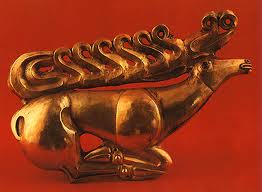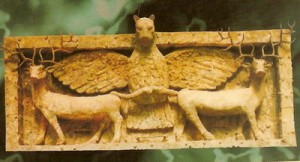Part 6
 We have talked about the descent into the earth’s interior. The symbol we have employed is so widespread as to go unnoticed. We know very well that our consciousness is not an object found inside the body; that there is no above or below; that it is absurd to pray to God, lifting one’s head toward a hypothetical “heaven” and putting on the pitiful and beseeching expression of a dog waiting for its owner to hand him the leftovers (not without the vague fear of a kick). The sinking sensation of the consciousness in its innermost recesses cannot be expressed in human language other than by resorting to analogous sensations of material human life. The origin of many important and ancient symbols (if we can talk of origins), and thus of their interpretation, is to be found in the need to express inner sensations through analogy (an analogy that really exists and that the human mind can recognize and employ) between these sensations and the sensations of ordinary life. The entire symbolism of the “descent into hell” is connected to it. Thus, in Egypt, the subterranean world, the neter khert, the dwelling place of the dead, is called “Amenti,” from the word Amen, meaning “invisible, occult.” Thus, the Greek Hades is likewise αεισηδ, invisible. It is necessary to descend into this underground, invisible world, illumined by the hidden sun, or Amen-Ra, the “Midnight Sun” of the Isaic initiation. This descent must be made without losing self-consciousness, without drinking or feeling the lethal effects of Lethe’s waters. On the contrary, one should drink from the fresh source of Mnemosine, the giver of immortality in Orphism, or from Dante’s waters of the river Eunoè. Mnemosine, memory, re-calling (from corda), who is opposed to Lethe and conquers him, is the Mother of the Muses; correspondingly, truth in Greek is a-letheia, and learning is none other, Platonically speaking, than anamnesis, or a remembering.
We have talked about the descent into the earth’s interior. The symbol we have employed is so widespread as to go unnoticed. We know very well that our consciousness is not an object found inside the body; that there is no above or below; that it is absurd to pray to God, lifting one’s head toward a hypothetical “heaven” and putting on the pitiful and beseeching expression of a dog waiting for its owner to hand him the leftovers (not without the vague fear of a kick). The sinking sensation of the consciousness in its innermost recesses cannot be expressed in human language other than by resorting to analogous sensations of material human life. The origin of many important and ancient symbols (if we can talk of origins), and thus of their interpretation, is to be found in the need to express inner sensations through analogy (an analogy that really exists and that the human mind can recognize and employ) between these sensations and the sensations of ordinary life. The entire symbolism of the “descent into hell” is connected to it. Thus, in Egypt, the subterranean world, the neter khert, the dwelling place of the dead, is called “Amenti,” from the word Amen, meaning “invisible, occult.” Thus, the Greek Hades is likewise αεισηδ, invisible. It is necessary to descend into this underground, invisible world, illumined by the hidden sun, or Amen-Ra, the “Midnight Sun” of the Isaic initiation. This descent must be made without losing self-consciousness, without drinking or feeling the lethal effects of Lethe’s waters. On the contrary, one should drink from the fresh source of Mnemosine, the giver of immortality in Orphism, or from Dante’s waters of the river Eunoè. Mnemosine, memory, re-calling (from corda), who is opposed to Lethe and conquers him, is the Mother of the Muses; correspondingly, truth in Greek is a-letheia, and learning is none other, Platonically speaking, than anamnesis, or a remembering.
 Even the symbolism of the stone, the occultum lapidem, that is found by rectifying the interior (or inferior, as it is written in the later variations of the Renaissance Hermeticist Basilus Valentinus, and now we can understand why), derives (though not chronologically) from an inner sensation. This at least appears very likely. Although an initial and uncertain sensation of sinking into the inner recesses of consciousness is easily accessible, in order to reach the sensation of “petrification” it usually needs a long period of assiduous practice of the ritual. An Italian text of the sixteenth century entitled The Practice of Philosophical Ecstasy, perhaps by Campanella, and published by D’Ancona alongside his work (Turin, 1854, vol. I, p. cccxxiii), says that at a certain stage of practice one becomes “as still as a plant or a stone.” This confirms how spontaneous and exact the comparison of reaching such a condition is to the recovery of the stone. According to the Rosicrucian Michael Maier, the Philosopher’s Stone is the very stone that Cybele forced Saturn to swallow, in order to save Jupiter, Saturn’s own son, from his father’s voracity; thus Jupiter was able to escape from time and become King of Olympus. The “black stone,” a symbol of Cybele, was taken to Rome and preserved on the Palatine by the Romans, who had owned and venerated another “lapis niger” for centuries in the Forum, at the beginning of the “via sacra” (sacred road). This stone had fallen from the sky and was called “abadir” by the Romans and “betyl” by the Greeks. According to René Guénon (Le roi du monde, 1958, p.76) the word “betyl” is the same as “Beth-el,” “house of God,” which is the name given by Jacob to the stone that he used as a pillow when he saw the house of God and the gate of heaven in his famous dream. It was also the name given by Jacob to the city near the place where he had his dream. Interestingly, according to Genesis the original name of that city was Luz. But luz in Hebrew is the name of an indestructible little bone to which the soul is connected after death until the day of “resurrection.” Luz is also the name of the almond tree. Near the city of Luz there was an almond tree, at the base of which there was a hole through which one could access an underground passage that led to the city of Luz, completely hidden. Thus we return to the symbol of the underground passage, which was associated with the symbol of the stone. The entire symbolism of the “spiritual building’ employed in the Gospel and the typical of Masonry, as well as the symbolism of the “Philosopher’s Stone,” is a development of this fundamental symbol that cannot be understood (nor taught) until the “hidden stone” has been found.
Even the symbolism of the stone, the occultum lapidem, that is found by rectifying the interior (or inferior, as it is written in the later variations of the Renaissance Hermeticist Basilus Valentinus, and now we can understand why), derives (though not chronologically) from an inner sensation. This at least appears very likely. Although an initial and uncertain sensation of sinking into the inner recesses of consciousness is easily accessible, in order to reach the sensation of “petrification” it usually needs a long period of assiduous practice of the ritual. An Italian text of the sixteenth century entitled The Practice of Philosophical Ecstasy, perhaps by Campanella, and published by D’Ancona alongside his work (Turin, 1854, vol. I, p. cccxxiii), says that at a certain stage of practice one becomes “as still as a plant or a stone.” This confirms how spontaneous and exact the comparison of reaching such a condition is to the recovery of the stone. According to the Rosicrucian Michael Maier, the Philosopher’s Stone is the very stone that Cybele forced Saturn to swallow, in order to save Jupiter, Saturn’s own son, from his father’s voracity; thus Jupiter was able to escape from time and become King of Olympus. The “black stone,” a symbol of Cybele, was taken to Rome and preserved on the Palatine by the Romans, who had owned and venerated another “lapis niger” for centuries in the Forum, at the beginning of the “via sacra” (sacred road). This stone had fallen from the sky and was called “abadir” by the Romans and “betyl” by the Greeks. According to René Guénon (Le roi du monde, 1958, p.76) the word “betyl” is the same as “Beth-el,” “house of God,” which is the name given by Jacob to the stone that he used as a pillow when he saw the house of God and the gate of heaven in his famous dream. It was also the name given by Jacob to the city near the place where he had his dream. Interestingly, according to Genesis the original name of that city was Luz. But luz in Hebrew is the name of an indestructible little bone to which the soul is connected after death until the day of “resurrection.” Luz is also the name of the almond tree. Near the city of Luz there was an almond tree, at the base of which there was a hole through which one could access an underground passage that led to the city of Luz, completely hidden. Thus we return to the symbol of the underground passage, which was associated with the symbol of the stone. The entire symbolism of the “spiritual building’ employed in the Gospel and the typical of Masonry, as well as the symbolism of the “Philosopher’s Stone,” is a development of this fundamental symbol that cannot be understood (nor taught) until the “hidden stone” has been found.